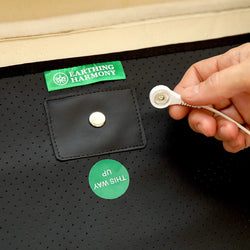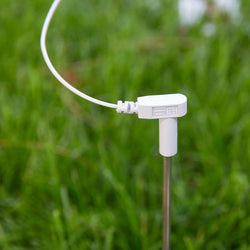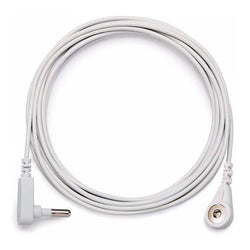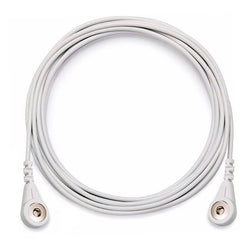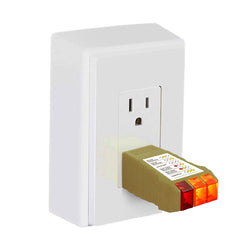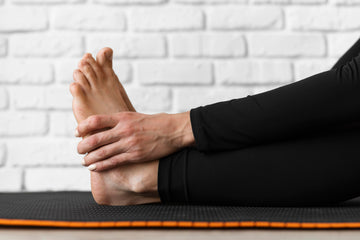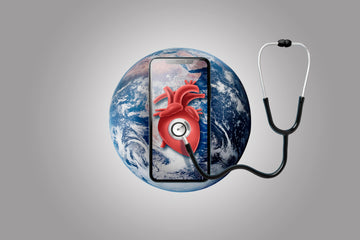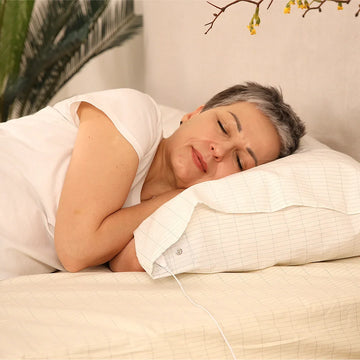What if the secret to your pain relief was as simple as connecting with the Earth?
Chronic pain affects millions of people worldwide, leading many of us to seek natural alternatives to traditional pain management methods. Grounding for pain relief, also known as earthing, is a simple yet powerful practice that involves direct skin contact with the Earth's surface. This natural method has shown promising results in reducing pain levels, inflammation, and emotional stress, making it a compelling solution for all of us struggling with persistent discomfort.
Unlike conventional treatments that often involve medications or invasive procedures, grounding offers a non-invasive, cost-free, and accessible way to support your body’s healing mechanisms. It is particularly beneficial for those of us looking to supplement our pain management strategies with holistic methods that align with nature’s rhythms.
Key Takeaways:
-
Grounding involves making direct contact with the Earth's surface to transfer free electrons into the human body, which can neutralize free radicals and reduce oxidative stress.
-
Scientific studies suggest grounding reduces blood viscosity, improves blood flow, and balances the autonomic nervous system, all of which contribute to pain relief and your improved overall health.
-
Simple grounding techniques, such as walking barefoot, gardening, or swimming in a river or lake, can be easily incorporated into your daily life to help relieve chronic pain and improve your quality of life over time.

What Is Grounding?
Definition
Grounding, or earthing, is the practice of physically connecting with the Earth's surface by walking barefoot, touching soil, or using grounding mats and grounding footwear that mimic natural contact. This direct connection allows your body to absorb negatively charged electrons from the Earth, which act as antioxidants and help restore balance to your body’s electrical system. It is a natural way of aligning your biological rhythms with the Earth’s natural frequencies, potentially leading to improved health outcomes.
How It Works
The Earth carries a natural electric charge, which transfers free electrons from the Earth into your body upon direct contact. These electrons act as natural antioxidants, neutralizing free radicals and reducing oxidative stress, which are primary contributors to chronic inflammatory conditions. This electrical exchange is vital because modern living has increasingly isolated people from the Earth's energy. Our rubber-soled shoes, highrise buildings, and artificial environments prevent direct earth contact. By re-establishing this connection, grounding can help reset biological processes, reduce your stress hormone levels, and promote healing on a cellular level.
Brief History
Grounding has roots in ancient healing traditions where people walked barefoot or slept on the ground to maintain health. Many cultures throughout history, including Native American traditions and Ayurvedic practices, emphasized the importance of staying connected to the Earth for optimal well-being. In modern times, scientific research has begun validating these historical practices, demonstrating grounding's physiological benefits in pain relief, reduced inflammation, and overall well-being. Researchers are now exploring how grounding can counteract the effects of industrialization and urbanization, which have led to increased exposure to electromagnetic fields and a disconnection from nature’s healing properties.

The Science Behind Grounding and Pain Relief
How Grounding Affects Your Body
Reduction in Inflammation
Scientific studies indicate that grounding reduces inflammatory markers in the human body. Chronic inflammatory conditions are a major cause of persistent pain, and grounding provides a natural way to counteract it by supporting the immune response. Inflammation is often a result of an overactive immune system reacting to stress, injury, or environmental toxins. By reducing pro-inflammatory cytokines and oxidative stress, grounding helps calm your immune system, allowing your body to repair itself more efficiently. This makes grounding an appealing therapy for us with autoimmune diseases, arthritis, and other chronic inflammatory conditions.
Impact on the Nervous System
Grounding has been shown to regulate the autonomic nervous system, shifting it from a stressed fight-or-flight state to a relaxed parasympathetic activation. This balance helps alleviate stress-related pain and has broad implications for your overall well-being. When your body is in a chronic state of stress, it produces high levels of cortisol, a stress hormone that contributes to muscle tension, headaches, and fatigue. By engaging in grounding practices, your body’s cortisol levels stabilize, leading to lower stress and reduced pain perception over time. This effect is especially beneficial for those of us suffering from tension-related disorders like migraines and fibromyalgia.
Improved Circulation
Enhanced blood flow from grounding supports oxygen and nutrient delivery to damaged tissues, accelerating healing and reducing pain levels. It also reduces blood viscosity, which helps prevent cardiovascular disease and blood clots. Improved circulation not only benefits people like us with pain conditions but also enhances overall vitality, cognitive function, and muscle recovery. Athletes who incorporate grounding into their routines report faster post-exercise recovery times, decreased muscle stiffness, and reduced delayed onset muscle soreness (DOMS). This highlights grounding’s potential in sports medicine and rehabilitation settings.

Scientific Studies Supporting Grounding for Pain Relief
Study 1: Grounding and Chronic Pain in Arthritis Patients
A study published in the Journal of Inflammation Research found that grounding significantly reduced chronic pain and stiffness in arthritis patients by decreasing inflammatory cytokines and promoting improved blood flow. Participants who engaged in grounding practices for extended periods reported long-term improvements in mobility and joint comfort, suggesting that grounding may be an effective complementary therapy for managing arthritis symptoms.
Study 2: Grounding and Muscle Recovery
A study in The Journal of Alternative and Complementary Medicine observed that grounded individuals who practiced grounding experienced faster recovery and reduced muscle soreness (DOMS) after intense exercise. This study also indicated that grounding might enhance the body's ability to repair microtears in muscles, leading to stronger and more resilient tissues over time. By reducing oxidative stress, grounding supports cellular repair mechanisms essential for our muscle regeneration and endurance.
Expert Opinion
Dr. Stephen Sinatra, a cardiologist and grounding advocate, states that “earthing is the most natural anti-inflammatory intervention available.” Researchers agree that grounding is a viable, non-invasive approach to pain management with clinical observations supporting its benefits. Dr. Gaétan Chevalier, another expert in the field, has conducted multiple studies indicating that grounding may play a crucial role in reducing symptoms of chronic illnesses, such as fibromyalgia and multiple sclerosis, by promoting cellular balance and reducing stress loads on the body.

Frequently asked questions about Grounding
How does grounding support wound healing?
Grounding has been shown to speed wound healing by reducing inflammation and improving circulation. Earth’s surface electrons are absorbed through direct skin contact, helping neutralize oxidative stress, which plays a role in delayed healing. Research evidence suggests that grounded participants experience faster tissue regeneration, with participants reporting less pain and improved recovery outcomes.
Can grounding help regulate blood pressure?
Yes, studies suggest that grounding may help regulate blood pressure by reducing stress and improving circulation. Those of us suffering from high blood pressure may see reduced blood pressures over time as grounding supports blood flow and reduces blood viscosity. Some experts in integrative medicine believe that grounding has significant implications for improving cardiovascular health and reducing the risk of cardiovascular events.

How does grounding impact red and white blood cells?
Grounding has biological effects on both red and white blood cells. It reduces blood viscosity, allowing red blood cells to flow more freely and transport oxygen efficiently. This supports wound healing and reduces the risk of heart disease. Additionally, grounding helps balance the immune system by supporting white blood cells, improving your body’s ability to fight infections and inflammation.
Does grounding help improve sleep?
Yes, many studies confirm that grounding can improve sleep quality by stabilizing the circadian rhythm and reducing nighttime cortisol levels. Participants in grounding studies have reported less pain, deeper rest, and waking up feeling more refreshed. Grounding products, such as grounding mats or sheets, allow for nighttime grounding and have been linked to long-term health implications in today's modern lifestyle.
How does grounding affect chronic conditions?
Grounding has significant implications for managing chronic conditions such as arthritis, fibromyalgia, and cardiovascular disease. The effects of grounding earthing include reduced inflammation, improved blood flow, and lower stress responses, all of which contribute to pain relief. Grounding has been explored in lifestyle medicine strategies for its potential to naturally reduce symptoms and enhance well-being.

What are the benefits of grounding on the aging process?
Grounding is believed to slow the aging process by reducing oxidative stress and chronic inflammation. Since inflammation is a key factor in age-related diseases, grounding can help minimize the effects of time on the body. Participants reported increased energy, reduced joint stiffness, and a youthful feeling over time.
How does grounding help with physiological dysfunction?
Physiological dysfunction, particularly in the nervous system, can be improved through grounding. It enhances autonomic tone, which helps regulate vital functions such as your heart rate and digestion. Improved autonomic tone leads to better stress management, lower anxiety levels, and enhanced overall resilience against diseases.
Can grounding be used in sports medicine?
Yes, grounding has been studied in sports med for its ability to speed wound healing, reduce muscle soreness, and improve recovery time. Athletes who practice grounding regularly, whether by walking barefoot or using a grounded yoga mat, have reported less pain and increased performance. Grounding participants in various studies showed better endurance and a quicker return to peak condition.
What is electronic nutrition, and how does it relate to grounding?
Electronic nutrition refers to the body's ability to absorb electrons from the Earth to support cellular function. Since modern life isolates people from natural electron transfer, grounding helps restore balance by allowing the body to receive these essential electrons, contributing to reduced inflammation, better circulation, and improved health.
How does grounding relate to public health?
Grounding has potential benefits for environmental and public health, as it is a simple, natural method of reducing inflammation and improving well-being. Promoting grounding as part of an integrative medicine approach could help address widespread chronic conditions, reducing the need for pharmaceutical interventions and offering a sustainable health solution.
Can grounding prevent cardiovascular events?
Studies suggest that grounding may lower your risk of cardiovascular events by reducing blood viscosity and promoting heart health. Grounding’s effects on red blood cells and circulation show it may help prevent blood clots, heart attacks, and strokes. These findings have significant implications for individuals at risk of heart disease.
Can grounding be done indoors?
Yes, indoor grounding options such as grounded yoga mats, grounding sheets, and conductive mats allow people to experience the benefits of grounding without stepping outside. These products are designed to replicate the natural connection to earth's surface electrons, offering similar health benefits, including improved sleep, better circulation, and reduced inflammation.
What research evidence supports grounding?
The Earthing Institute and various scientific studies provide research evidence supporting the health benefits of grounding. Studies have observed significant implications for chronic pain management, inflammation reduction, and cardiovascular health. Grounded participants consistently report less pain, improved well-being, and better sleep quality in controlled studies.








 Shoes
Shoes
 Boots
Boots
 Sandals
Sandals

 Shoes
Shoes
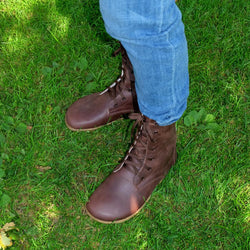 Boots
Boots
 Sandals
Sandals

